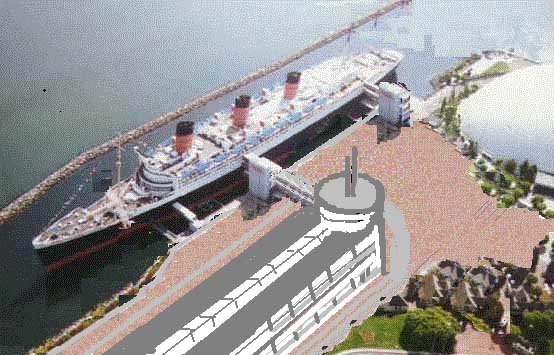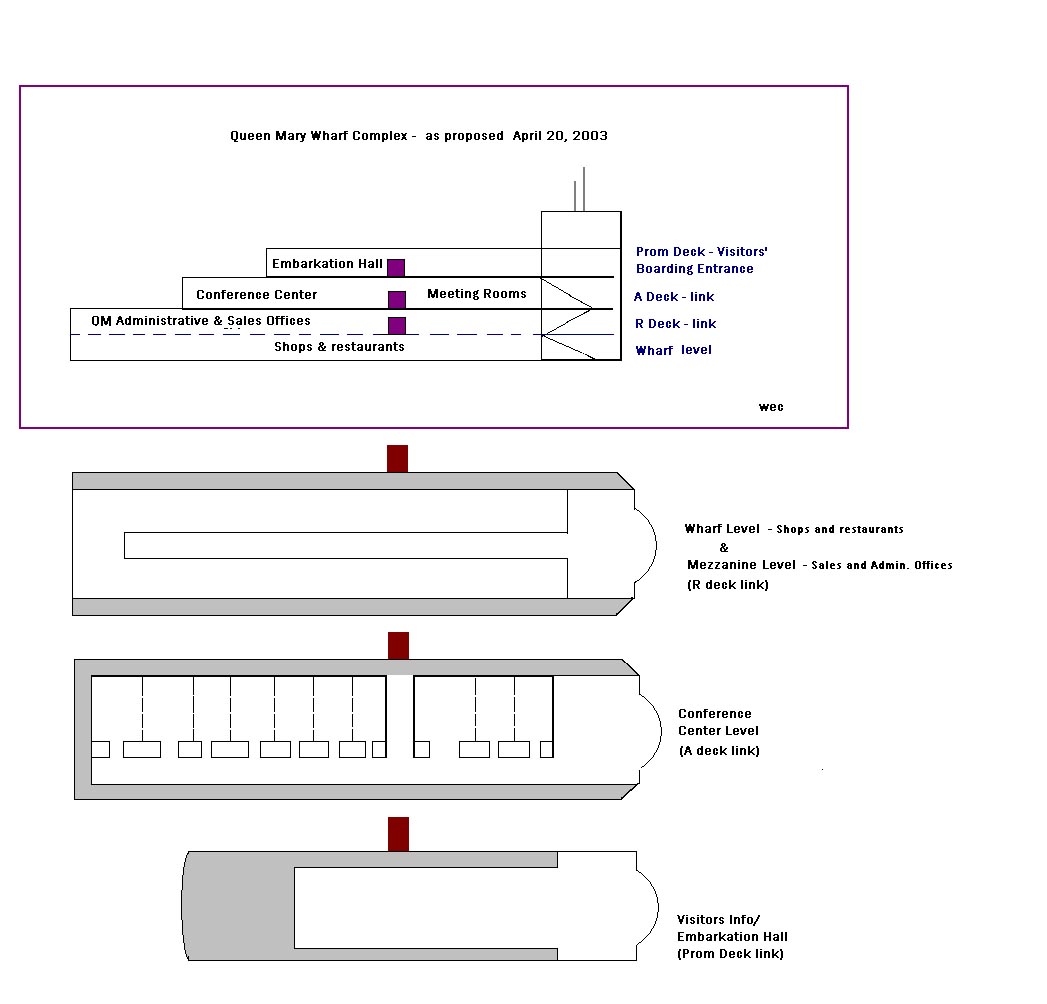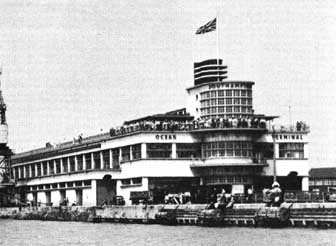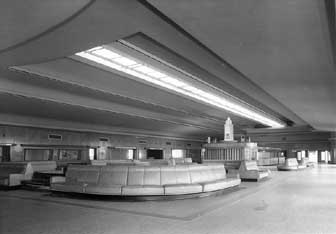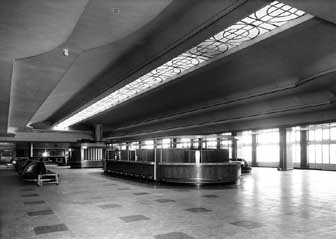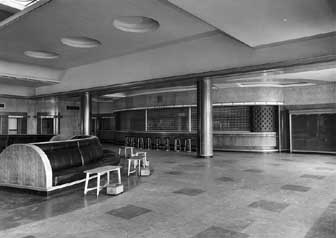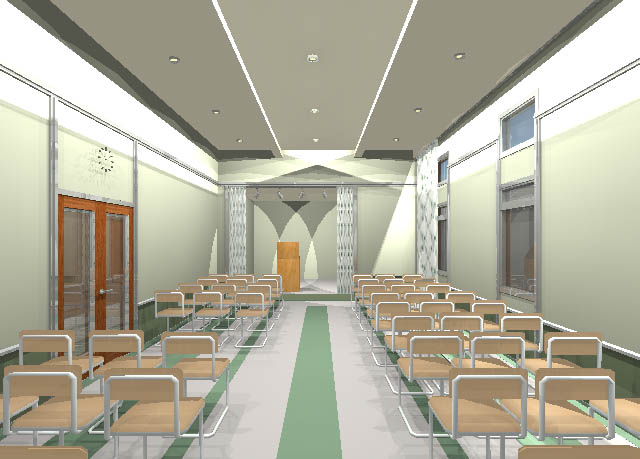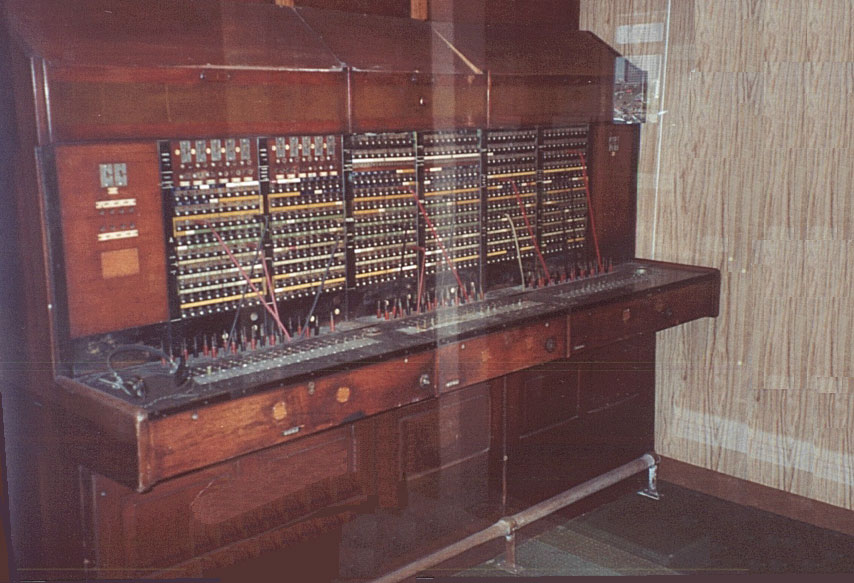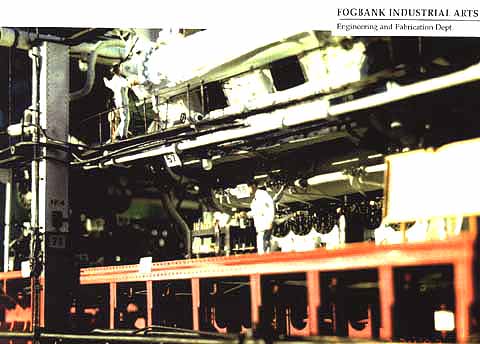We believe that the Queen Mary must be primarily a permanent exhibit on the design, construction and history of one specific ocean liner – arguably the greatest ocean liner of the twentieth century. It naturally incorporates an attraction, a hotel and catering business and might also include a high- end live entertainment center and art deco reproduction merchandise showcase. We believe that the property, not the ship should be the target for major routinely changing venues. This is why we recommend installing:
The "soft program" aboard the ship, by which we mean daily activities,
events, menus, and entertainment programs, can and should change routinely – perhaps with the season. But we reject the concept of developing a series
of special effect "rides" and even "exhibits" aboard the ship. We believe that they become an impediment to seeing, appreciating and
interacting with the Queen Mary itself. No ersatz, special effects "ride" or "exhibit" should ever be allowed to obscure the beauty of the ship as
built - and restored. In designing our multiple tour program for the Queen Mary we considered a number of factors, including the need for distinct, non overlapping tour routes and distinct thematic foci for each tour:
Other important considerations include:
The role of the Visitor Information Center For a multiple tour program to work, visitors must first have some overall orientation to the ship, some idea of what the tour program includes, and what can be seen on each of the guided tours. In other words they need to know what they will be missing if they don’t take all of the tours. For greatest dramatic effect the Visitors Information Center should NOT be a new construction that is aboard the ship. Walking into a gutted and rebuilt facility in the hull tells visitors that they are visiting what remains of the Queen Mary. We believe the Visitor Information Center is best housed in a facility, possibly resembling the Ocean Terminal where the Queen Mary docked in Southampton, located adjacent to the ship. It would serve to house the facilities to orient and educate tourists as well as provide the means for physical access to the upper decks of the ship.
Proposed position of a terminal-like building near the ship. The example here is inspired by Southampton's "Ocean Terminal", but a totally new design may also be appropriate, built to serve as a Visitor Information Center and incorporating new retail space and state of the art business meeting rooms.
Sideview of proposed building The displays in the Visitor Information Center educate the visitors on the chronology of the ship, her significance and the role played by her in twentieth century history. Below is a possible floor plan for each level of this new building.
Four views of the original Ocean Terminal in Southampton.
The Ocean Terminal in Southampton seen from the South Side, and a waiting room inside.
Two more interior views . Embarkation Hall, the uppermost level of the Visitor Information Center, would house displays on the tour program itself. Their purpose is to encourage tourists to want to take all of the tours. Ticket booths and tour initiation areas as well as snacks and souvenirs would also be available here. The Guided ToursProposed tours shown in a sideview of the ship. Click on this image to expand it to full size. We see three major and distinct guided tour routes. Each has its own theme and focus and each covers physical areas of the ship that are distinct.
This tour provides an in depth look at the amenities available to first class passengers whilst the ship was at sea. Tourists gather at their scheduled tour time in the embarkation hall of the Ocean Terminal/Visitor Information Center and move onto the Queen Mary at Promenade Deck via the forward boarding tower. The tour begins in the enclosed promenade then moves into the main hall. Moving through the forward circle of shops and other amenities with a knowledgeable guide, the group stops for a film/video presentation in the original first class lecture room. Once regaining the main hall the group moves through the "golden circle" of lounges that epitomized the glamour that was the pre-war Queen Mary.
A rendering of a possible reconstruction of the lecture room, by Jeff Taylor. From the main lounge the group goes via the internal route to the long gallery and then to the first class smoking room, and then returns via the ballroom and the starboard gallery to the main lounge. From here it returns to the main hall. (If any of these restored facilities is in use during the tour, it is avoided by use of the lobbies and exterior enclosed promenades.) From the main hall the group descends the grand
staircase to Main deck where the restored tourist bureau and a suite are
visited. Again down the grand staircase to A deck where the purser's desk
is viewed as well the back office where the Queen Mary's original safe was
kept and a portion of the original Queen Mary telephone exchange
(originally located on B deck) is displayed as well as a sweeping view of
the passageways.
Tourists gather at their scheduled tour time in the embarkation hall of the Ocean Terminal/Visitor Information Center and move onto the Queen Mary at Promenade Deck via the forward boarding tower. The tour moves forward though the port side of the enclosed promenade down to Main Deck via the exterior stairway, and enters the Third Class main entrance. From here they visit the Garden Lounge, then go down the third class staircase to A deck and see the smoking room and the bow and forecastle areas. Re-entering the ship via the smoking room, the group continues down the hall to B deck where they visit the third class playroom and view the synagogue. Entering the cinema they stop for a video presentation on these areas and aspects of the ship. Moving forward they penetrate the crew areas and visit the seamen’s accommodations in the bow. Moving down to "R" deck via the staircase in the crew area they tour the mail-handling facilities and then go past the re-installed original fire station. They then return to the third class entrance and visit the third class dining room. Moving down to current "C" deck via the third class staircase they view a section of reconstructed third class cabins on the starboard forward section of the ship and then cross through the great sliding doors that separated third class from the crew areas – and onto the Working Alley. The group visits the reconstructed third class and kosher kitchens, leading greasers' mess and dining room – then crosses the hall and briefly views the adjacent first class pool at the basin level and returns to the working alley to visit the trimmers' dining room (possibly housing the reconstructed hospital displays?) and the print shop. The groups descends to current "D" deck and exits the ship via the entrance to the proposed contemporary working alley in the forward port side of the ship and returns to the Ocean Terminal/Visitor Information Center. Between tours, visitors might return to the ship and shop on Promenade deck and lunch in the new visitors' restaurants on Sun Deck as well as view self guided areas on both Sun and Sports Deck.
The group then enters a large elevator that is inserted into the shaft of Hold # 1 and is carried down to the “tank top” level of Hold # 1. With their guide providing an interesting explanation the group views Hold # 1 and moves aft (through a pair of new watertight doors set into the bulkhead and into the large and majestic Hold # 2.Here they learn about how cars were lowered into the ship, how many could be transported and what other cargo was typically carried on this and other great liners. Proceeding aft they stop in the gutted but stabilized water softening plant and boiler rooms 1 and 2. Here they see a large screen video presentation on the conversion and gutting of the great liner. From here the group walks along the lowest deck to the simulated forward turbo generator room and boiler rooms 3 and 4. (Robin Jacobs' reconstructed area with his narrative tour).
The group then proceeds though shaft alley near where John Pedder was crushed to death and allegedly his ghost is sometimes seen - and up the escalator to the emergency steering area. They next move forward again on the port side and view the propeller in the underwater box. The group is escorted into a gift shop area on D deck that serves as the termination point for this tour. The gift shop’s focus is on the engineering and mechanical aspects of the Queen Mary and other great liners.
The new purpose of the revamped ship walk is to offer access to interesting areas that are not on the three guided tour routes. These exhibit areas will be manned with knowledgeable docents. In addition to educating visitors, the ship walk provides for entertaining places to visit and see between guided tours. We see the following areas open to visitors as part of the self-guided ship walk: A Deck – The Third Class Smoking Room -
restored to serve as a lounge and reserved for daytime visitors with steward service. A
beverage, (tea, coffee, juice), and a pastry are complimentary with the full fare
admission ticket. Promenade Deck
Sun Deck
Sports Deck
Specialty Tours/ProgramsIn addition to the regularly scheduled program of tours and the self-guided areas, specialty programs would be run as required. These might include;
Related articles from the Retained Riches, Lost Glories and Hidden Treasures areas series of articles are available on this site: Proposed Tour A related areas:
Proposed Tour B related areas:
Proposed Tour C related areas:
Proposed Self Guided Areas:
|

